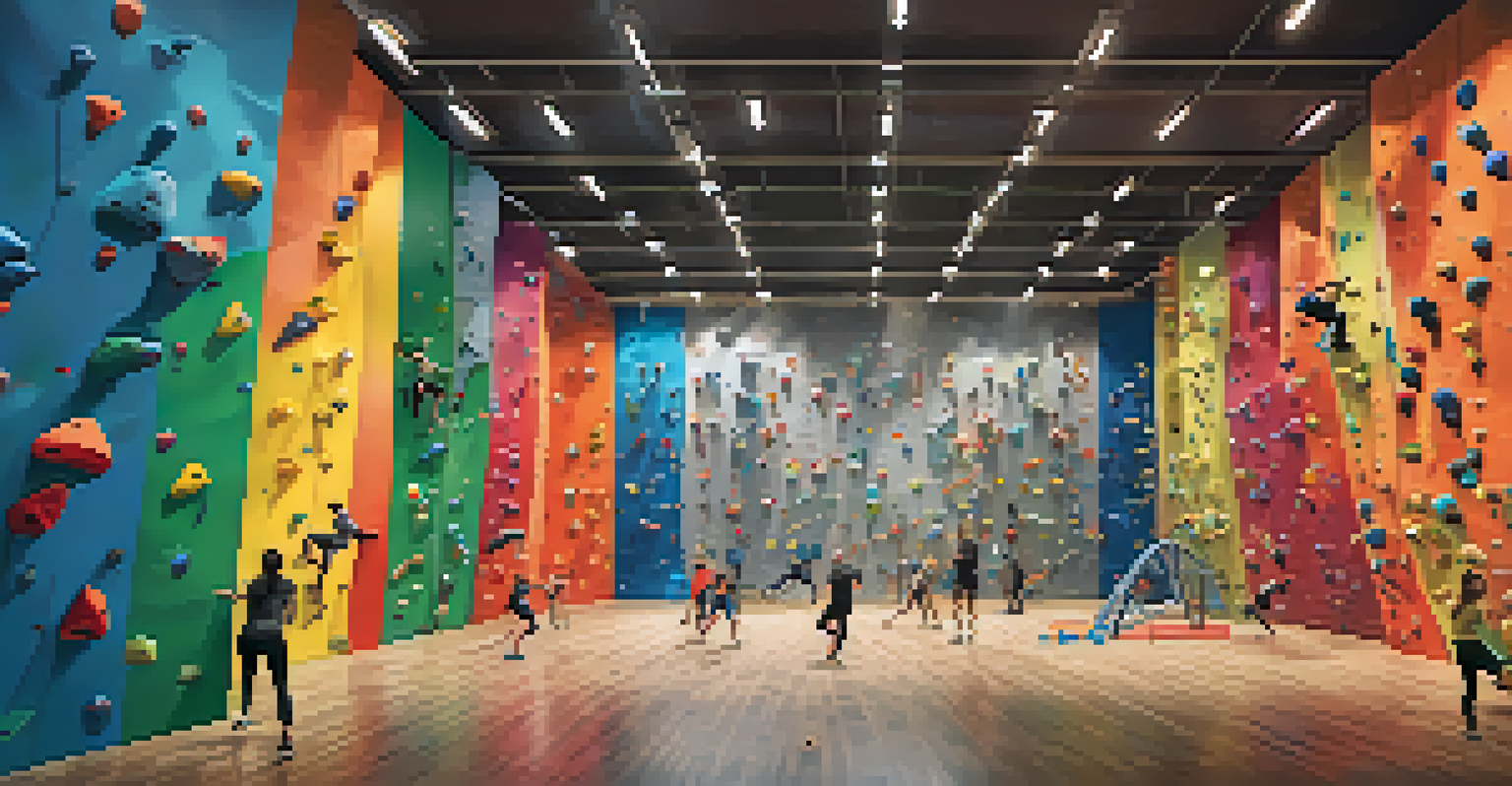Incorporating Climbing into Your Bodybuilding Regimen

Understanding the Benefits of Climbing for Bodybuilders
Climbing isn't just an adrenaline rush; it offers numerous benefits for bodybuilders. It targets multiple muscle groups simultaneously, promoting overall strength and endurance. This unique form of exercise enhances grip strength, which is essential for lifting heavier weights in the gym.
Climbing is not just a sport; it's a way to improve yourself physically and mentally.
Moreover, climbing provides a cardiovascular workout that many bodybuilders overlook. The aerobic benefits can improve your stamina, enabling you to push harder during your lifting sessions. The combination of strength training and cardio can lead to better muscle recovery and growth in the long run.
Incorporating climbing into your routine can also help prevent workout monotony. When you engage in a new activity, it can reignite your passion for training and keep you motivated. This fresh approach can lead to unexpected gains, both physically and mentally.
How Climbing Complements Traditional Weightlifting
While bodybuilding focuses on sculpting specific muscles, climbing demands the use of your entire body. This dynamic movement helps improve your functional strength, which is the type of strength you need in everyday life. As you climb, your body learns to coordinate muscle groups, enhancing overall performance.

Additionally, climbing can improve your body awareness and balance. These skills are crucial when executing complex lifts in the gym, as they help prevent injuries and ensure proper form. By mastering these elements on the climbing wall, you can translate them back to your bodybuilding regimen.
Climbing Boosts Bodybuilding Gains
Incorporating climbing into your routine enhances strength, endurance, and grip, leading to better performance in traditional weightlifting.
Lastly, the explosive movements involved in climbing can enhance your power output. This translates to heavier lifts and greater muscle gains when you return to traditional bodybuilding exercises. Think of it as cross-training for your muscles, making them more versatile and resilient.
Essential Climbing Techniques for Bodybuilders
To reap the benefits of climbing, start by mastering basic techniques such as foot placement and body positioning. These fundamentals will not only improve your climbing ability but also enhance your core stability, which is vital for effective weightlifting. As you become comfortable, you can experiment with more advanced techniques like dynamic moves and overhang climbing.
Strength does not come from physical capacity. It comes from an indomitable will.
Once you’ve grasped the basics, consider incorporating bouldering into your routine. Bouldering focuses on shorter climbs without ropes, emphasizing strength and technique. This can be an excellent way to build muscle without the extended time commitment of longer climbs.
Don’t forget about the importance of rest and recovery. Just like in bodybuilding, your muscles need time to adapt and grow after climbing sessions. Schedule climbing days strategically within your training week to avoid overtraining and ensure you’re maximizing both strength and recovery.
Creating a Balanced Training Schedule
Integrating climbing into your bodybuilding regimen requires careful planning. Start by assessing your current training schedule and identify days when you can add climbing sessions without compromising your lifting days. A balanced approach is key to ensuring that both activities complement each other rather than detract from your progress.
For example, you might consider climbing on your cardio or active recovery days. This way, you can maintain your strength training frequency while still enjoying the benefits of climbing. Alternatively, you could do a mixed session, where you lift weights followed by a short climbing practice, allowing for a comprehensive workout.
Balanced Training Schedules Matter
A well-planned training schedule that integrates climbing and bodybuilding ensures holistic fitness and prevents overtraining.
Keep in mind that consistency is crucial. Regularly engaging in both climbing and bodybuilding will lead to gradual improvements in strength and endurance. By treating both activities with equal importance, you’ll create a training regime that promotes holistic fitness and growth.
Nutrition Tips for Climbers and Bodybuilders
Nutrition plays a vital role in both climbing and bodybuilding success. A well-balanced diet rich in protein, complex carbohydrates, and healthy fats will fuel your workouts and aid recovery. As you introduce climbing into your routine, it’s essential to adjust your nutritional intake to meet the increased energy demands.
Consider incorporating snacks rich in carbohydrates before climbing sessions for an energy boost. Foods like bananas, energy bars, or oatmeal can provide the necessary fuel to keep you going. Post-workout, focus on protein-rich meals to promote muscle repair and growth after both climbing and weightlifting sessions.
Hydration is equally important. Climbing can be a physically demanding activity, and staying well-hydrated will enhance your performance and recovery. Aim to drink water throughout the day, and consider electrolyte supplements if you’re engaging in prolonged climbing sessions.
Injury Prevention Strategies for Climbing and Bodybuilding
Injuries can hinder progress in both bodybuilding and climbing, so it's crucial to prioritize injury prevention. Start by incorporating a thorough warm-up routine before each session. This should include dynamic stretches and movements that activate the muscles you'll be using, ensuring you're prepared for the workout ahead.
Strengthening your stabilizing muscles is also key. Exercises that target the shoulders, core, and hips will provide the support needed for both climbing and lifting. Consider adding specific exercises like rotator cuff strengthening or core stability workouts to your regimen.
Nutrition Fuels Performance
A balanced diet rich in protein, carbohydrates, and hydration is essential to support the increased energy demands of both climbing and bodybuilding.
Lastly, listen to your body. If you feel discomfort or pain, allow yourself time to rest and recover. Ignoring these signals can lead to more severe injuries that may sideline you from both climbing and bodybuilding. Prioritizing your well-being will ultimately lead to better performance and longevity in both activities.
Tracking Progress and Adjusting Your Routine
As you incorporate climbing into your bodybuilding regimen, tracking your progress is vital. Keep a training journal where you can log your climbing sessions alongside your weightlifting workouts. This will help you identify patterns, improvements, and areas that may need adjustment.
Additionally, consider taking regular photos or measurements to visually track your progress. Sometimes, the changes in your physique might not be immediately apparent, but having concrete evidence can be a great motivator. This visual feedback can help you stay committed to your goals.

Lastly, don’t hesitate to adjust your routine based on your progress and feedback from your body. As you become stronger in both areas, you may find that certain climbs become easier or that you can lift heavier weights. Embrace these changes, and allow your training regimen to evolve as you do.